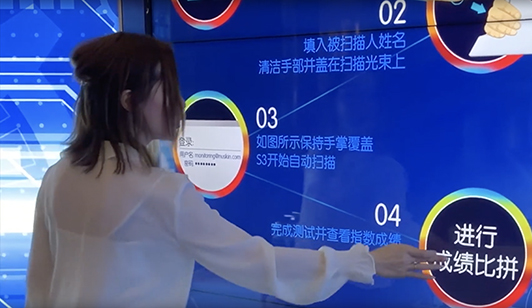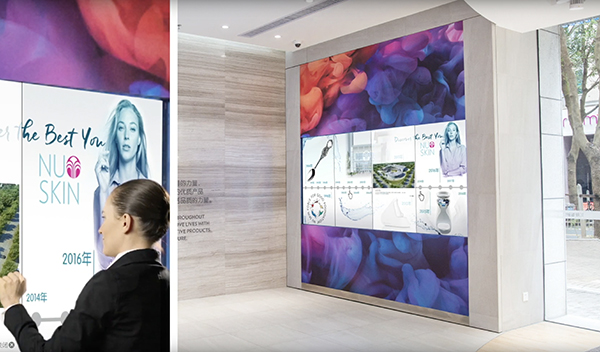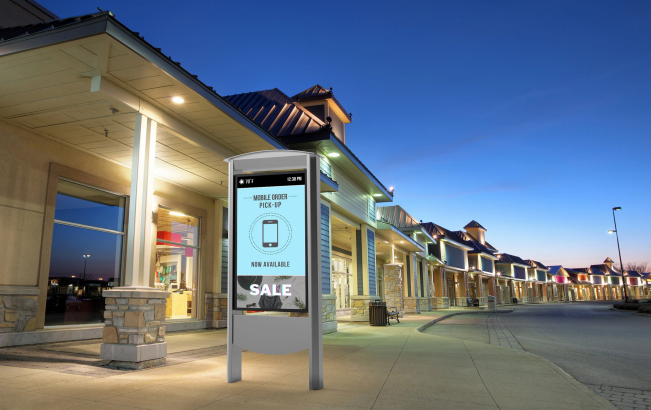Digital Signage Advances Retail Experiences
By Cindy Davis
Digital signage has evolved from panels that display static images to those that integrate with technologies capable of capturing consumer profiles to push personalized content, as well as report-on and analyze selected consumer data to increase sales. While still in its infancy, these integrated technologies are fueled by big data and the Internet of Things (IoT). 5G is expected to accelerate the capabilities and adoption of enhanced signage technologies.
Bullish on Brick-and-Mortar

Retail industry research points to the resurgence of consumers shopping at brick-and-mortar locations but warns that the in-store customer experience requires an omni-channel approach providing continuity of the experience throughout the customer’s journey. This will require supporting technologies to be incorporated.
The 2019 Omni-Channel Retail Report: Generational Consumer Shopping Behavior Comes Into Focus by Big Commerce states, “The ability to touch or try on an item before purchase is the number one reason U.S. consumers shop at brick-and-mortar stores across all generations.”
In a surprising turn from the online shopping experience, Generation Z (Gen Z) and Millennials both cite price as a large reason for shopping in-store. And Gen Z, Millennials and Generation X (Gen X) all cite speed and convenience as important factors for shopping in-store.
IoT Enables a Holistic Customer Journey
Approximately ten years ago, Jose Avalos founded the Digital Signage Group at Intel. Today, Avalos is the Vice President of the Internet of Things Group, and General Manager of the Visual Solutions at Intel which are responsible for providing technologies and products for platforms such as digital signage, interactive kiosks, intelligent vending, smart whiteboards, intelligent shelving among others. “Basically, my team is responsible for any platform that integrates digital signage as an ingredient and also for the computing that supports those type of solutions,” says Avalos.
Avalos says that computing power, bandwidth and sensors are what drives the Internet of Things. Technologies like computer vision, analytics, artificial intelligence (AI), and 5G are why big companies like Intel are investing a lot of money. The cost of each of these areas has dropped precipitously during the past couple of years, kicking off a new relationship between retailers and its customers. What does this mean for digital signage? “We can see the sign and the sign can see us,” says Avalos. “This is incredible.”

“We are looking at a customer journey which starts at home which goes across all platforms, TVs, mobile, web, digital signage, and smartphones,” says Florian Rotberg, Managing Director at Munich, Germany-based Invidis Consulting. Whether the in-store experience includes smart mirrors or furniture shopping using augmented reality, “Consumers nowadays expect to see this user experience.” Curated content, and curated products are where brick-and-mortar can add value.
No matter where the retail shop is located around the globe, digital needs to be an integral part of the retail design process, but with caution. Because of General Data Protection Regulation (GDRP) and cultural differences in each of the European countries, the in-store digital experience is a bit different than the U.S., says Rotberg, but the trends are similar. He adds while facial recognition is widely accepted in China, “it's absolutely unacceptable here [Germany].”
To draw a consumer into a store, the digital experience should make shopping more interesting, more interactive, more engaging, more thrilling says, Thomas Walter, Strategic Product & Business Development at NEC Display Solutions Europe. “But first and foremost, the digital signage content must be relevant.”
Stephen Choi, Head of North America Displays at Samsung Electronics America agrees. Not only can you feature relevant dynamic content with high visibility imagery on digital signage, there can be an interactive component. “A consumer can touch the content on the display and virtually overlay a photo of [themselves] to see whether the blue shirt would look better than the green shirt with the khakis,” he added.
But these experiences in and of themselves are only entertainment without collecting key data.
Big Data Completes the Customer Journey
 As recently as three years ago, retailers couldn’t calculate the ROI of digital signage, which made the category a tough sell. Today, digital signage coupled with sensors, cameras other technologies can provide select customer data enabling retailers to analyze behavior and become a part of the holistic customer’s journey. “Analytics give brands the opportunity to have that continuous dialogue with consumers to understand what products and services to develop, that are going to be attuned to the needs and desires of the consumer,” says Intel’s Avalos. Intel’s research cites 80 percent of brands reporting a significant increase of opportunity sales when using digital signage.
As recently as three years ago, retailers couldn’t calculate the ROI of digital signage, which made the category a tough sell. Today, digital signage coupled with sensors, cameras other technologies can provide select customer data enabling retailers to analyze behavior and become a part of the holistic customer’s journey. “Analytics give brands the opportunity to have that continuous dialogue with consumers to understand what products and services to develop, that are going to be attuned to the needs and desires of the consumer,” says Intel’s Avalos. Intel’s research cites 80 percent of brands reporting a significant increase of opportunity sales when using digital signage.
Big data companies, as well as digital signage display companies such as NEC, Samsung, Sharp and others have been quick to provide integrated platforms for its customers to gather data and more importantly make business intelligence decisions based on analytics.
Engaging with customers through intelligent, automated and customized content leading to a sale based on data gathered is the holy grail.
In a simplified example: a customer picks up a pair of red shoes and a sensor transmits information to the digital sign to deliver more information on the product, and hopefully results in a sale. “In this case, the signage is now transforming, I think this is quite important, it's transforming from an advertisement or from an information tool to a holistic marketing and exchange tool,” says NEC’s Walter. The signage is now joining the shopper along the entire journey and helps make a good decision. “This helps marketers to understand quicker which campaign is working and which products are selling.” Additionally, the data can help inform inventory stock, and upsell other products. “If the customer bought red shoes, maybe they would like red T-shirts or sunglasses.”
Data gathered through artificial intelligence combined with analytics platforms are poised to completely transform the customer’s journey and the influence a retailer can have on that journey. “From our perspective, the whole digital AI experience will optimize the consumer shopping experience, improve business operations, provide data collection, analytics, customer visits, advertising, sales spikes, time of the day, the weather effects on a particular store location, and then the content optimization,” says Samsung’s Choi. “And that is all tied to analytics engine.”
Think Agile
In 2020, the rollout of 5G should be underway. With speeds of up to 1,000 times faster than what 4G can now provide, consumers and retailers will have the ability to interact seamlessly and proactively. 5G will be a major driver sealing the deal for the technologies that enable digital signage to become an active component of the customer’s journey.
Implementing an omni-channel approach to marketing and taking advantage of an ecosystem that provides real-time actionable data throughout the customer journey is key for retailers to remain competitive in today’s landscape.
In its 2019, Shopper Data Debrief: Creating a Real-Time Value Exchange In Store, business intelligence platform company PSFK states, “In order to stay ahead of the competition, breakdown silos within your organization and make sure that all relevant parties have access to data and the ability to act upon it. Empower employees at all levels, from CMO to store associate, to identify and act upon opportunities identified through data analytics for innovation in retail.”
Learn more about trends and use cases for digital signage from Invidus at InfoComm 2019.





